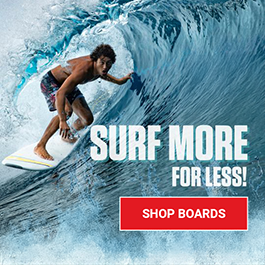TIPS
PROGRESS IN SURF
BEGINNER
Mathis Crozon • Pro Surfer
He introduces you to some tutorials and tips to get started in surf!
Mathis tested the COMET 7'2 surfboard. A board that is 100% Made In France, and 100% recyclable because it’s produced using Tough-Tec technology. This board was designed by Jon Henderson, a top-class shaper from Santa Cruz, California.
It’s an easy ride, maneuverable, has good forward speed, and is built to last. The COMET surfboard comes with fins made of 100% recyclable fishing nets.
A board that guarantees years of fun without any sacrifice on performance with a reduced environmental impact.
In collaboration with Surfsession
#TIPS | Take-off
In surf, Take-off means: getting onto the wave, then balancing yourself on the board. There are 2 stages to take-off.
First thing, paddling hard. You have to paddle super hard to get up enough speed to get your board onto your wave.
The second part is setting yourself on the board. Keep your arms alongside your body on the board. Once you’ve found your balance, in one single movement jump to an upright position standing on the board.
When you’re standing on the board, flex your knees and fix your eyes far ahead.
Want to learn more?
When you are about to start paddling to get onto your wave, look carefully to see which way it’s breaking if it’s a left or a right. When you’ve turned round and you’re ready to paddle, have one final big paddle with your torso and chin flat down on the board. Once you’re standing up, keep your feet and weight forwards to help you accelerate well.
The COMET 7’2 surfboard got big volume, is really stable and make your take-offs easier.
#TIPS | Le canard
The duck dive is a technique for enabling you and your board to pass under the incoming waves as you paddle out. It breaks down into three stages.
Stage one: the paddle. Try to ramp up your paddling more than usual to pick up some speed, this will help you force the board down beneath the water surface.
Second stage: forcing the board down. Put your arms along the sides of the board and, using your body weight, push the board down under the water as the wave arrives.
Third and final stage: re-surfacing. When you can surface again, you have to use your knee or your foot on the tail of your board and push to get up after the wave breaks.
Want to learn more?
If you meet turbulence under the wave, keep a really firm grip on both of the board’s rails, otherwise, it can easily escape from your hands.
#TIPS | Surfing Spirit
Before start surfing, it’s important to understand the rules.
First, the priority rules. One surfer for each wave. The surfer closest to the peak when the wave starts breaking always takes priority. Never try to get on a wave if there is already another surfer on it. On a double-breaking wave, right and left, two surfers can go at the same time as long as they choose opposite directions.
Second up: the safety rules. Always use a board leash. Choose a spot that corresponds with your skill level. Make your way steadily towards the peak without getting in the way of surfers already on the wave.
Final tip, for when you’ve finished your sessions. Pick up any rubbish you can find on your way off the beach and stay chilled!


